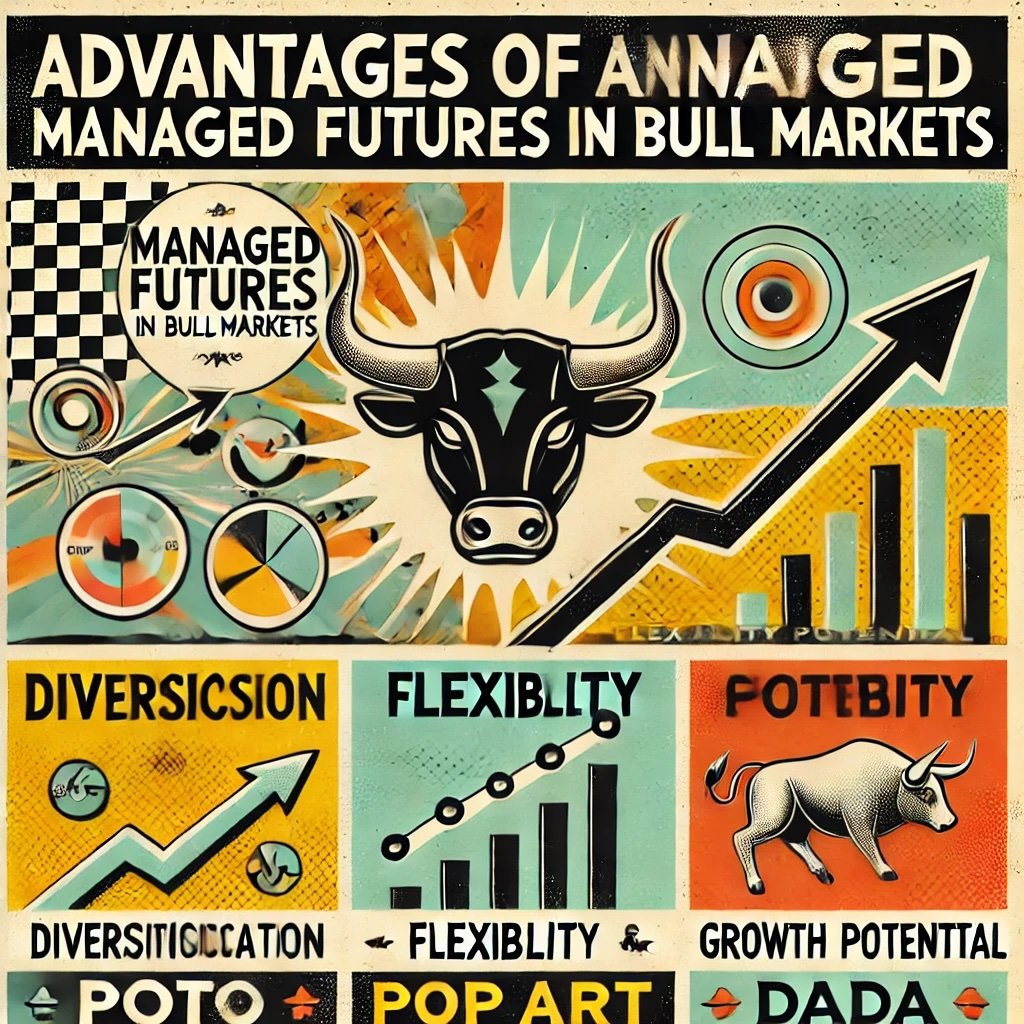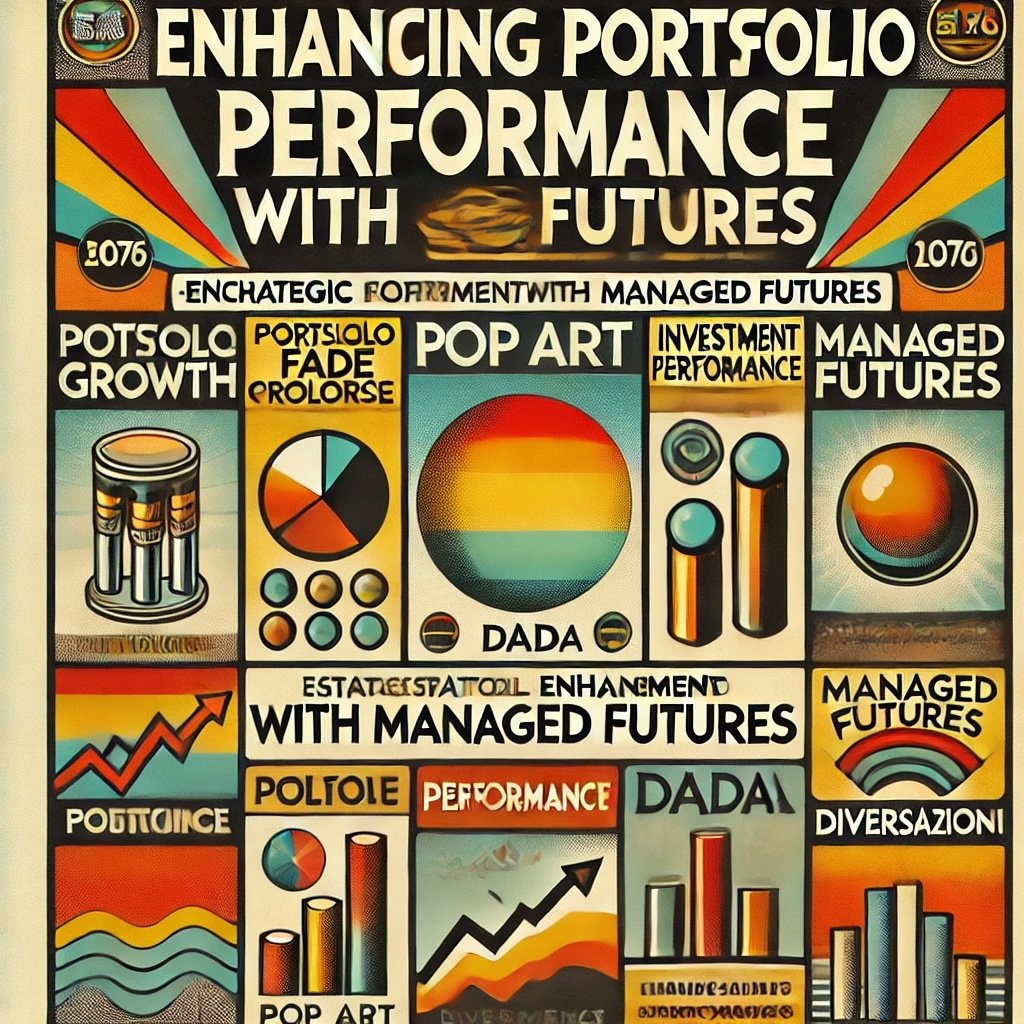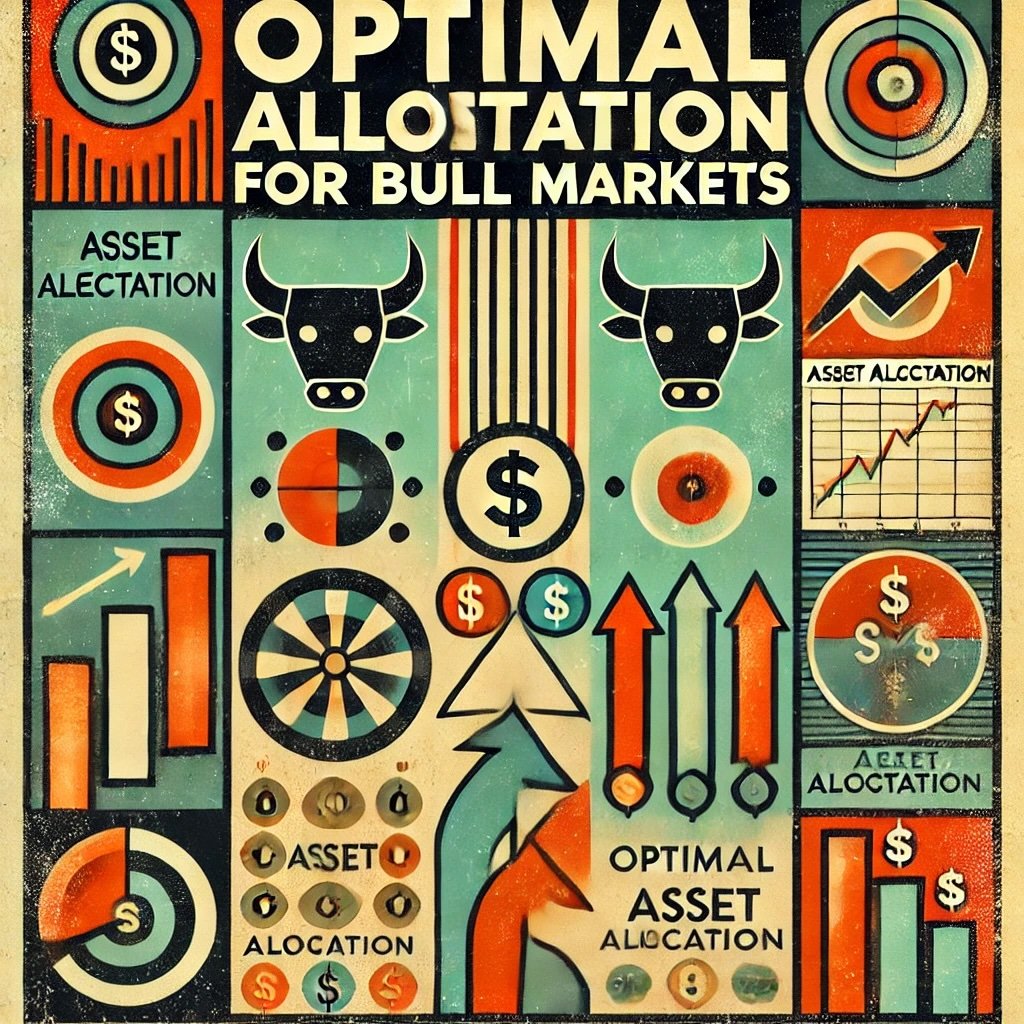Bull markets capture attention and drive excitement. As prices rise steadily, investor optimism grows, creating a cycle of increased economic growth and returns on investments. Typically, bull markets are characterized by a surge in asset prices, high trading volumes, and overall positive sentiment in the market. Investors, buoyed by economic growth and strong corporate earnings, often embrace more aggressive strategies, seeking to capitalize on upward momentum.
source: Optimus Futures on YouTube
But how do managed futures play a role here? Managed futures are traditionally viewed as tools for diversification, often used to hedge against downturns. Yet they hold substantial potential even in bullish market scenarios. Managed futures use professional managers to trade across various markets, like commodities, currencies, and interest rates, which creates a unique positioning strategy for both growth and risk mitigation.

Understanding Managed Futures in a Bull Market
What Are Managed Futures?
Managed futures are investment strategies that use futures, options, and other derivatives to create positions across multiple markets. Managed by skilled professionals, these funds have the flexibility to either take long positions in a rising market or short positions when downturns are anticipated. Unlike traditional portfolios that are often restricted to stocks and bonds, managed futures diversify by tapping into non-traditional assets. This makes them resilient and adaptable—two qualities valuable in any market environment.
Navigating Bullish Conditions
In a bull market, managed futures can still provide significant value. This might seem counterintuitive since many view managed futures as a safety net against losses. However, the adaptability of these funds allows them to leverage rising trends across a broader array of assets. Managed futures can actively engage in commodities, which often rise alongside equities in growth-driven markets. Similarly, currencies and interest rates frequently shift in response to macroeconomic conditions, opening additional pathways for profit.

Key Characteristics of Bull Markets
In a bull market, assets grow in value across sectors. Several key characteristics are at play:
- Rising Asset Prices: In a bull market, demand for equities and other growth-oriented assets grows as investors anticipate higher returns. This creates consistent price increases across multiple sectors.
- Investor Optimism: Positive sentiment becomes pervasive, driving further interest in higher-risk and high-reward investments, which in turn fuels the market’s upward trajectory.
- Economic Expansion: As businesses thrive, the broader economy often sees growth in employment, consumer spending, and corporate earnings, reinforcing the bullish cycle.
Understanding these features helps investors optimize their strategies, especially when considering managed futures in a largely growth-focused portfolio.
Introduction to Managed Futures in Bull Markets
The primary aim here is to explore how managed futures provide unique value even during bull markets. We’ll dive into the specific benefits, from capturing diverse growth opportunities to safeguarding against the possibility of a sudden correction. Managed futures don’t just provide a hedge in bear markets; they have the flexibility to enhance returns when markets rise.
Investors can leverage these insights to build a more robust portfolio, combining managed futures with traditional equities to maximize growth potential while managing volatility. Whether you’re focused on long-term growth or seeking to add versatility to your portfolio, managed futures offer a blend of security and opportunity that’s rare in other investment types.

The Mechanics of Managed Futures and Their Bull Market Potential
Managed futures bring a unique set of strategies to an investor’s toolkit. Unlike typical buy-and-hold strategies, managed futures are designed to adapt quickly, taking advantage of trends in real-time. By leveraging instruments like futures, options, and other derivatives, managed futures allow investors to pursue profit in both rising and falling markets. The versatility of these strategies opens the door to growth even in bullish market conditions, offering a compelling option for those looking to enhance their portfolio performance.
How Managed Futures Work
Managed futures rely on futures contracts and options to build strategic positions across multiple asset classes. These include not just traditional assets like equities but also commodities, currencies, and interest rates. Here’s a quick breakdown of the process:
- Strategic Asset Selection: Managed futures focus on a broad range of asset classes beyond stocks and bonds. By diversifying into commodities or currencies, they allow investors to tap into non-traditional growth areas.
- Active Management and Adjustments: Professional managers monitor market trends and economic indicators, adjusting positions regularly to reflect changes. In a bull market, they may hold long positions to capture upward momentum, while in times of economic downturn, they may adopt short positions to mitigate losses.
- Risk-Adjusted Flexibility: Unlike static portfolios, managed futures are adaptable. If a certain sector becomes overheated, the fund can shift focus to a more stable asset class or adopt a short position to offset risk.
The use of derivatives amplifies this adaptability. Futures and options allow managers to execute large trades with minimal upfront capital, offering both liquidity and flexibility to enter or exit positions as needed. This level of active management provides an edge that passive, buy-and-hold portfolios can’t match.

Profiting in Both Rising and Falling Markets
One of the standout features of managed futures is their dual capacity for profit. While traditional portfolios are often limited to long positions—betting that an asset’s price will rise—managed futures can take short positions as well. This approach lets managers pursue returns in virtually any market environment, even during corrections within a bull market. In rising markets, managers can capitalize on trends by maintaining long positions, riding the growth wave for as long as it lasts. If they spot signals that a trend might reverse, they can adjust accordingly, possibly profiting from that downturn.
The Flexibility of Long and Short Positions
In a bullish environment, flexibility is a significant advantage:
- Taking Long Positions: In sectors like technology or energy that are booming, managers can hold long positions to capture gains as these assets appreciate. The timing of entry and exit is key, and managed futures experts use market analysis tools to identify optimal moments.
- Utilizing Short Positions: Even within a bullish context, corrections or sector-specific downturns happen. Managed futures can take advantage of these by shorting overvalued assets, adding a layer of protection and profit potential.
This approach allows for targeted growth in high-performing areas while maintaining balance.
Why Flexibility Matters in Bull Markets
In a bull market, it’s tempting to assume that all sectors will perform equally well, but this isn’t always the case. Managed futures shine here by selectively targeting growth-driven asset classes. For instance, in previous bull markets, commodities such as oil or precious metals have sometimes outpaced equities. Managed futures can allocate more weight to these sectors, capturing higher returns without being overly exposed to stock market volatility.
Furthermore, managed futures funds rely on data-driven strategies to identify trends early and react quickly. In bullish conditions, this proactive stance can help investors stay ahead of the curve. Rather than merely riding the market’s upswing, managed futures can capture profits from emerging trends, enhancing portfolio performance through active adjustments.

Advantages of Managed Futures in Bull Markets
In a bull market, most investors look to maximize gains as prices rise across various assets. However, the strength of a bull run also carries inherent risks, such as sudden corrections or sector-specific downturns. Managed futures bring a unique advantage here. They allow investors to diversify across a range of asset classes, from commodities to currencies and more, which can capture growth opportunities while managing risk exposure. This dual capacity makes managed futures a powerful tool for those aiming to benefit from bullish trends without leaving their portfolios exposed to sudden market shifts.
Capturing Growth Through Diverse Asset Classes
One of the primary benefits of managed futures lies in their exposure to a variety of asset classes. While traditional portfolios often concentrate on equities, managed futures go beyond stocks and bonds, including assets such as commodities, currencies, and even interest rates. This diversified exposure can enhance returns during a bull market, especially when sectors outside of equities are also thriving.
For instance, during a bull market, commodities like oil, metals, or agricultural products often see increased demand, which pushes their prices higher. Managed futures take advantage of these growth opportunities by allocating resources to these assets, allowing investors to profit from rising commodity prices without having to directly trade in those markets. Similarly, certain currencies may appreciate in value during economic expansion, providing another area of potential gain.
Diversification Beyond Equities
Managed futures offer exposure to asset classes that don’t always move in lockstep with the stock market. Here’s how:
- Commodities: As the global economy grows, demand for raw materials rises, lifting commodity prices. Managed futures can tap into these trends.
- Currencies: Bull markets often see currency shifts as nations capitalize on global trade. Managed futures can take long positions on appreciating currencies.
- Interest Rates: In a growing economy, interest rates may rise. Managed futures managers can strategically position to profit from such movements.
This diversified approach allows managed futures to leverage growth across sectors, adding layers of profitability beyond what’s possible with stock-heavy portfolios. By focusing on assets that might outperform equities in certain conditions, managed futures can capture gains more broadly.

Risk Management in Overheated Markets
While bull markets bring optimism, they can also become overheated. Sudden corrections—short, sharp drops in asset prices—are not uncommon as markets surge. Managed futures offer a solution by positioning portfolios to reduce risk when markets get frothy. Their ability to short-sell or shift assets during downturns creates a protective buffer against these unpredictable drops.
Consider historical bull markets where corrections hit without warning. In the late 1990s tech boom, for example, technology stocks were surging, but when the bubble burst, many portfolios took substantial hits. Managed futures could have offset these losses by shorting overvalued tech assets or by shifting allocations toward non-correlated sectors like commodities or bonds. In this way, managed futures serve as an effective hedge, balancing exposure to high-growth assets with measures to reduce volatility.
Examples of Managed Futures in Action
Examples from past markets highlight how managed futures have protected investors in times of market excess:
- 2000 Dot-Com Bubble: As tech stocks soared, managed futures that shorted these overvalued assets were able to mitigate the impact when the bubble burst.
- 2008 Financial Crisis: Commodities and safe-haven assets outperformed, and managed futures helped cushion losses in traditional asset classes.
- 2020 Pandemic Shock: Managed futures in commodities and currencies offered stability when equities faced massive swings.
By providing tools to counter sudden downturns, managed futures bring a level of resilience to portfolios.

Enhancing Portfolio Performance with Managed Futures
When the market is on a steady upward trajectory, most investors are eager to amplify their returns. Managed futures, with their versatile strategies, offer a way to achieve this. While stocks and bonds remain the core of many portfolios, managed futures add another layer of performance through trend-following strategies and diversification beyond equities. These features enable portfolios to benefit from the market’s positive movement while also introducing elements of protection and balance.
Boosting Returns through Trend-Following Strategies
One of the hallmarks of managed futures is their ability to identify and capitalize on trends. Trend-following strategies are designed to profit from sustained upward price movements by “following the trend.” Managers look for patterns in price movements across a variety of asset classes and position investments accordingly. For instance, if commodities or interest rates are experiencing an upswing, managed futures can lock into these trends to maximize returns.
For example, during a bull market, commodity prices often rise due to increased demand from a growing economy. A trend-following strategy might take a long position in commodities like crude oil or precious metals, riding the wave as prices climb. Similarly, when interest rates move upward as part of a growth-focused monetary policy, managed futures might take advantage of this trend through futures contracts on bonds or currencies, further boosting portfolio returns.
Common Trend-Following Tactics in Bull Markets
Managed futures employ a range of trend-following techniques that adapt well to bull markets:
- Momentum Trading: Identifies assets gaining upward momentum and rides the wave for short-term profits.
- Breakout Strategies: Looks for assets breaking past key price levels, indicating potential for sustained growth.
- Relative Strength: Selects assets demonstrating stronger price performance than others, focusing on sectors outperforming during bull markets.
These strategies don’t depend solely on stock price increases, allowing managed futures to find profitable trends across asset classes.

Complementing Equity Holdings
Managed futures are an excellent complement to stock-heavy portfolios, offering unique returns that aren’t tied to traditional equity markets. While stocks represent a slice of economic growth, managed futures diversify by tracking different assets and trends. This approach doesn’t just add another layer of performance—it also reduces risk by offsetting possible declines in stock prices with gains from other assets.
For example, in a stock-focused portfolio, managed futures can improve stability by offering exposure to non-correlated assets like currencies or agricultural commodities. When the stock market becomes volatile or even experiences corrections within a bull market cycle, these non-equity positions help stabilize the portfolio’s performance.
How Managed Futures Complement Equities
Managed futures work alongside equities by diversifying the growth drivers in a portfolio:
- Non-Correlated Performance: Gains from commodities or interest rates don’t move in lockstep with stocks, adding balance.
- Additional Growth Avenues: While stocks benefit from corporate growth, managed futures capture gains from commodities, currencies, and more.
- Dynamic Positioning: As stocks grow, managed futures adjust positions, enhancing performance without duplicating equity holdings.
For instance, during a prolonged bull market in equities, managed futures might focus on areas with high growth potential, like industrial metals or emerging market currencies, capturing gains in areas less directly connected to the stock market. This creates a more robust portfolio that grows with the broader economy but remains cushioned from stock market-only risks.

Potential Risks and Considerations for Managed Futures in Bull Markets
While managed futures offer intriguing benefits in a diversified portfolio, they’re not without potential drawbacks. In a strong bull market, these investment strategies can face unique challenges, particularly if they’re competing with pure equity holdings. Additionally, fees and complexity associated with managed futures can impact overall returns. Investors considering managed futures in bull markets need to weigh these factors to make an informed choice.
Drawbacks of Managed Futures in Strong Bull Markets
In a strong bull market, direct equity investments can often outperform managed futures. Since equities tend to benefit directly from rising economic growth and investor optimism, they typically capture higher returns than managed futures strategies, which are designed for both bullish and bearish conditions. Managed futures funds may adopt a more diversified approach, investing in commodities, interest rates, and currencies alongside equities, which can dilute their performance compared to pure equity investments during extended market rallies.
For instance, if an investor’s managed futures position includes commodities or currencies that aren’t rising in tandem with equities, the portfolio’s overall performance may fall short of expectations in a thriving stock market. This opportunity cost can be a significant consideration, particularly for investors seeking to maximize growth during a strong bull market. Managed futures’ diversification, while advantageous in volatile markets, can sometimes act as a limiting factor when the market is in full swing.
Key Scenarios Where Managed Futures May Underperform
- Strong Equity Rallies: Pure stock portfolios may outpace managed futures in rising markets.
- Diversification Away from Equities: Exposure to commodities or currencies can drag returns if they don’t align with the bull market trend.
- Missed Equity-Specific Gains: Managed futures don’t focus solely on equities, potentially missing out on gains driven by sector-specific or stock-specific surges.

Fees and Complexity
Managed futures funds typically come with higher fees than traditional mutual funds or ETFs, which can impact net returns over time. These fees often include management fees, performance fees, and sometimes additional operational expenses, as managed futures require active, professional management. For investors, these costs can eat into returns, especially during periods when managed futures underperform compared to equities.
Another factor to consider is the complexity of managed futures strategies. These funds rely on derivatives such as futures and options, which can be complicated for investors unfamiliar with such instruments. The complexity of these products means that investors must thoroughly evaluate them before committing. Understanding the fund’s strategy, knowing its historical performance, and ensuring alignment with investment goals are essential steps. Without this clarity, investors risk misaligning managed futures with their portfolio’s broader objectives.
Considerations Regarding Fees and Complexity
- Management and Performance Fees: Managed futures funds often charge higher fees, affecting net gains.
- Operational Complexity: Involvement with derivatives makes these funds more complex, requiring a closer review of their strategies.
- Investor Knowledge Requirement: Understanding managed futures takes time, as they involve a more intricate structure than traditional funds.
Balancing the Drawbacks with Potential Benefits
To balance these potential drawbacks, investors should assess their risk tolerance and investment goals. Managed futures may still be a valuable addition for those seeking diversification and a hedge against volatility, but it’s crucial to weigh these benefits against the higher fees and potential underperformance during bull markets. This careful evaluation will help determine if the advantages of managed futures align with your portfolio’s overall strategy, especially when equity markets are trending positively.
Quick Tips for Navigating Managed Futures in Bull Markets
- Evaluate Performance: Compare managed futures returns with equity returns to understand potential trade-offs in bull markets.
- Assess Costs Carefully: Ensure that the fees align with the expected value added to your portfolio.
- Understand the Strategy: Review the fund’s approach and evaluate how its diversification aligns with your risk tolerance and return expectations.

How Managed Futures Help Investors Profit During Bull Markets: 12-Question FAQ
What exactly are managed futures?
Managed futures are professionally run strategies that trade futures and options across global asset classes—commodities, equities, bonds, and currencies—with the flexibility to go long or short and to systematically follow trends or other quant rules. This lets them pursue returns beyond traditional stock/bond portfolios while actively managing risk.
Do managed futures really add value in a bull market?
Yes. In bull runs, many managed-futures programs ride equity-linked or commodity uptrends, capture moves in rates and FX, and re-risk faster after corrections. They can enhance return while still offering diversification if equities wobble mid-cycle.
How do they make money when stocks are already climbing?
Most managers use trend-following (time-series momentum). In a bull market that often means:
Long equities (index futures) as trends persist
Long pro-growth commodities (energy, industrial metals)
Systematic tilts in rates/FX aligned with policy and growth trends
The edge is breadth (many markets) plus rules (disciplined entries/exits).
Can managed futures keep up with a roaring stock market?
Sometimes—but not always. When equity rallies are broad, smooth, and persistent, many CTAs keep pace. When rallies are choppy, sector-specific, or mean-reverting, equities can outpace them. Think of managed futures as a return enhancer + diversifier, not a guaranteed equity beta replacement.
What’s the diversification benefit during bull markets?
Correlations are dynamic. In equities-up regimes, managed futures often show low to modest correlation to stocks because returns can also come from commodities, FX, and rates. That reduces portfolio volatility and can soften intra-bull drawdowns.
How do managers handle sudden corrections inside a bull?
Rules trigger de-risking or short signals as trends break. Many systems flip from long to short or move to cash if price action violates breakout/MA rules. This drawdown control is a key reason investors keep managed futures even when they’re optimistic on stocks.
Which sectors tend to contribute most in equity bull markets?
Energy & industrial metals during global expansions
Equity index futures when uptrends are steady
Rates/FX when policy or growth differentials trend (e.g., rising yields, strong/weak currencies)
The leadership rotates; the multi-asset canvas lets CTAs follow whichever tape is strongest.
What allocation size makes sense alongside equities?
Common ranges are 5–20% of a diversified portfolio. A practical start: 10% sleeve funded pro-rata from stocks/bonds. More risk-tolerant or institution-style investors sometimes go 15–20%, especially if they value crisis convexity and trend breadth.
What are the main trade-offs and risks in bull markets?
Opportunity cost if a pure equity melt-up outruns diversified trend strategies
Fee drag (management + performance)
Model risk (whipsaws in choppy tapes)
Capacity/implementation differences across managers and funds
How should I select a managed-futures fund for a bull market?
Screen for:
Process clarity (trend vs multi-strategy; timeframes)
Costs (TER + perf fees)
Liquidity/vehicle (’40-Act mutual fund, UCITS, ETF, LP)
Behavioral fit: review max drawdown, recovery time, MAR/Sharpe, and rolling correlation to equities
What does rebalancing look like with a managed-futures sleeve?
Set a banded policy (e.g., ±20% around target weight). In strong equity uptrends, the sleeve may lag—rebalance adds to it; after pullbacks where the sleeve holds up or gains, rebalancing harvests and restores equity exposure. Discipline preserves the diversification edge.
Bottom line: Why keep managed futures in a bull?
Because bull markets aren’t straight lines. Managed futures can participate in uptrends across many markets, adapt faster to regime wobbles, and limit left-tail damage—often improving the portfolio’s compound return versus an equity-only approach over a full cycle.
Implementing Managed Futures in Your Bull Market Strategy
Investing in managed futures can add diversity and resilience to a portfolio, especially during bull markets. This strategy doesn’t necessarily replace traditional equity holdings but complements them, providing a layer of risk management and diversification. If you’re considering adding managed futures to your investment mix, understanding the options available and how to allocate them within a bull market framework is key.
Ways to Invest in Managed Futures
Investors interested in managed futures have several options, each with its own features, costs, and accessibility:
- Mutual Funds: Many mutual funds offer managed futures as part of their diversified strategy. These funds provide exposure to managed futures strategies through a standard mutual fund structure, making them relatively straightforward to invest in. Mutual funds tend to be managed by professionals and can be a good fit for those looking for a more hands-off approach.
- ETFs: Exchange-traded funds (ETFs) with a managed futures focus offer another accessible option. ETFs are typically lower-cost than mutual funds and can be traded like stocks, which adds flexibility. Managed futures ETFs provide exposure to various asset classes, including commodities, currencies, and interest rates.
- Direct Managed Futures Accounts: For more personalized exposure, investors can consider direct managed futures accounts. These accounts involve a direct relationship with a managed futures firm, offering customized strategies based on the investor’s specific goals and risk tolerance. While they require a higher minimum investment, direct accounts provide the most tailored approach, though at a potentially higher cost.
Key Factors for Choosing a Managed Futures Product
- Historical Performance: Look at how the product has performed over time, particularly in various market conditions. Consider performance during past bull markets and downturns to understand resilience.
- Strategy Focus: Each managed futures fund has its own strategy, some focusing on trend-following, others on commodities, and others on a diversified approach. Match the strategy with your investment goals.
- Cost: Managed futures products come with varying costs, including management fees and sometimes performance fees. Weigh the fees against the potential benefits and compare with similar products.

Optimal Allocation for Bull Markets
When adding managed futures to a bull market strategy, balance is essential. While managed futures can enhance performance, particularly through diversification, they should typically only make up a portion of the portfolio rather than the entirety. Here’s how to approach allocation:
- Define Allocation Based on Risk Tolerance: The optimal allocation depends on individual risk tolerance and overall portfolio objectives. For conservative investors, a small allocation (e.g., 5–10%) in managed futures might be sufficient. This provides diversification without heavy commitment.
- Higher Allocation for Risk Management: For investors looking to counterbalance stock-heavy portfolios, a moderate allocation (10–20%) may help balance growth potential with risk management. This level allows exposure to the growth of a bull market while maintaining a defensive position.
- Integrating with Traditional Equity Holdings: Managed futures work best as a complement to equities rather than a replacement. In a bull market, equities often outperform, so keeping a strong equity base alongside managed futures can enhance returns while managing risk.
With managed futures as part of a growth-focused portfolio, you can enjoy the benefits of diversification and risk management. This addition, when well-allocated, can support your portfolio’s resilience through both bull and bear market cycles.
Important Information
Comprehensive Investment Disclaimer:
All content provided on this website (including but not limited to portfolio ideas, fund analyses, investment strategies, commentary on market conditions, and discussions regarding leverage) is strictly for educational, informational, and illustrative purposes only. The information does not constitute financial, investment, tax, accounting, or legal advice. Opinions, strategies, and ideas presented herein represent personal perspectives, are based on independent research and publicly available information, and do not necessarily reflect the views or official positions of any third-party organizations, institutions, or affiliates.
Investing in financial markets inherently carries substantial risks, including but not limited to market volatility, economic uncertainties, geopolitical developments, and liquidity risks. You must be fully aware that there is always the potential for partial or total loss of your principal investment. Additionally, the use of leverage or leveraged financial products significantly increases risk exposure by amplifying both potential gains and potential losses, and thus is not appropriate or advisable for all investors. Using leverage may result in losing more than your initial invested capital, incurring margin calls, experiencing substantial interest costs, or suffering severe financial distress.
Past performance indicators, including historical data, backtesting results, and hypothetical scenarios, should never be viewed as guarantees or reliable predictions of future performance. Any examples provided are purely hypothetical and intended only for illustration purposes. Performance benchmarks, such as market indexes mentioned on this site, are theoretical and are not directly investable. While diligent efforts are made to provide accurate and current information, “Picture Perfect Portfolios” does not warrant, represent, or guarantee the accuracy, completeness, or timeliness of any information provided. Errors, inaccuracies, or outdated information may exist.
Users of this website are strongly encouraged to independently verify all information, conduct comprehensive research and due diligence, and engage with qualified financial, investment, tax, or legal professionals before making any investment or financial decisions. The responsibility for making informed investment decisions rests entirely with the individual. “Picture Perfect Portfolios” explicitly disclaims all liability for any direct, indirect, incidental, special, consequential, or other losses or damages incurred, financial or otherwise, arising out of reliance upon, or use of, any content or information presented on this website.
By accessing, reading, and utilizing the content on this website, you expressly acknowledge, understand, accept, and agree to abide by these terms and conditions. Please consult the full and detailed disclaimer available elsewhere on this website for further clarification and additional important disclosures. Read the complete disclaimer here.




